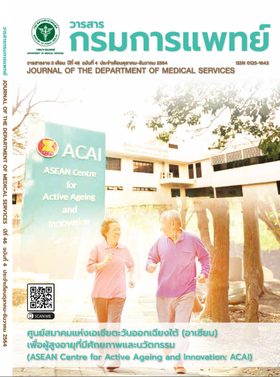Effects of Falls Prevention Exercise Program on Gait and Falls Risk in Community-dwelling Older Adults
Keywords:
elderly, falls, falls prevention training, gait, falls riskAbstract
Background: Falls are the most frequent and serious problems in community-dwelling older people. Therefore, the effective exercise program to improve balance and prevent falls are necessary.Objective: To examine the effects of falls prevention exercise program on gait and falls risk in community-dwelling older adults.Method: Sixty community-dwelling older adults were allocated into two groups: (1) Participants underwent the falls prevention exercise program for one hour per session, three times per week for three months (experimental group), and (2) Participants received a fall prevention knowledge brochure (control group). Measurements were administered three times: pre-intervention, post-intervention and 1-month follow-up period. 2 x 3 repeated measures ANOVA or Friedman test and Wilcoxon signed-ranks Test were used to analyze data. Significant level was set at p < 0.05.Result: Participants in experimental group performed significantly better in post-intervention and 1-month follow-up period on muscle strength, reaction time, postural sway, PPA score, cadence, gait speed, TUG, anticipatory postural adjustment in first step duration and percent double support time than pre-intervention. Moreover, participants in experimental group performed significantly better on stride length in post-intervention than pre-intervention assessment. Although, this study found better reaction time and PPA score in control group but participants in control group had more fear of falling score in post-intervention than pre-intervention assessment.Conclusion: This falls prevention exercise program can improve gait and muscle strength especially in long term effect which resulted in decrease in falls risk. Therefore, this exercise program is an effective intervention to prevent falls and be able to reduce risk of falls in elderly
References
Assantachai P. Condition falls in the elderly and prevention.
In: Assantachai P. Health problems are common in older people and prevention. Bangkok: Union creation 1999: p51-66.
Kitkumhang V, Kittimanon N, Pannarunothai S. Risk factors of fall in elderly in the community. Journal of Health Science 2006; 15: 787-99.
Legters K. Fear of falling. Phys Ther 2002; 82: 264-72.
O’Loughlin JL, Robitaille Y, Boivin JF, Suissa S. Incidence of and risk factors for falls and injurious falls among the communitydwelling elderly. Am J Epidemiol 1993; 137: 342-54.
Robertson MC, Campbell AJ, Gardner MM, Devlin N. Preventing injuries in older people by preventing falls: a meta-analysis of individual-level data. J Am Geriatr Soc 2002;50:905-11.
Barnett A, Smith B, Lord S, Williams M, Baumand A. Communitybased group exercise improves balance and reduces falls in at-risk older people: a randomized controlled trial. Age Ageing 2003;32:407–14.
Lord SR, Castell S, Corcoran J, Dayhew J, Matters B, Shan A, et al. The effect of group exercise on physical functioning and falls in frail older people living in retirement villages: a randomized, controlled trial. J Am Geriatr Soc 2003;51:1685-92
Sherrington C, Michaleff ZA, Fairhall N, Paul SS, Tiedemann A, Whitney J, et al. Exercise to prevent falls in older adults: an updated systematic review and meta-analysis. Br J Sports Med 2017; 51: 1750-8.
Puipanichsiri P, Sungkarat S, Boripuntakul S, Jinajin S, Tanakietpinyo S, Nantachai G, Ruangrukrien B. Comparison of the effectiveness of fall prevention gg programs in healthy elderly. J Gerontol Geriatr Med 2020; 19: 47-63.
Somdet Phra Sangharaj Nyanasamvara Geriatric hospital Chonburi province. Falls prevention exercise in elderly handbook. 1st ed. Bangkok: Beyond Publishing; 2019.
Lord SR, Menz HB, Tiedemann A. A physiological profile approach to falls risk assessment and prevention. Phys Ther 2003; 83: 237-52.
Mancini M, Salarian A, Carlson-Kuhta P, Zampieri C, King L, Chiari L, et al. ISway: a sensitive, valid and reliable measure of postural control. J Neuroeng Rehabil 2012; 9: 59.
Botolfsen P, Helbostad JL, Moe-Nilssen R, Wall JC. Reliability and concurrent validity of the Expanded Timed Up-and-Go test in older people with impaired mobility. Physiother Res Int 2008; 13: 94-106.
Lord SR, Lloyd DG, Nirui M, Raymond J, Williams P, Stewart RA. The effect of exercise on gait patterns in older women: a randomized controlled trial. J Gerontol A Biol Sci Med Sci 1996; 51:M64-70.
Rehman RZU, Zhou Y, Del Din S, Alcock L, Hansen C, Guan Y, et al. Gait Analysis with Wearables Can Accurately Classify Fallers from Non-Fallers: A Step toward Better Management of Neurological Disorders. Sensors 2020; 20: 6992.
Pijnappels M, van der Burg PJ, Reeves ND, van Dieën JH.
Identification of elderly fallers by muscle strength measures. Eur J Appl Physiol 2008; 102: 585-92.
Montesinos L, Castaldo R, Pecchia L. Wearable Inertial Sensors for Fall Risk Assessment and Prediction in Older Adults: A Systematic Review and Meta-Analysis. IEEE Trans Neural Syst Rehabil Eng 2018; 26: 573-82.
Uemura K, Yamada M, Nagai K, Ichihashi N. Older adults at high risk of falling need more time for anticipatory postural adjustment in the precrossing phase of obstacle negotiation. J Gerontol A Biol Sci Med Sci 2011; 66: 904-9.
Downloads
Published
How to Cite
Issue
Section
License
Copyright (c) 2022 Department of Medical Services, Ministry of Public Health

This work is licensed under a Creative Commons Attribution-NonCommercial-NoDerivatives 4.0 International License.
บทความที่ได้รับการตีพิมพ์เป็นลิขสิทธิ์ของกรมการแพทย์ กระทรวงสาธารณสุข
ข้อความและข้อคิดเห็นต่างๆ เป็นของผู้เขียนบทความ ไม่ใช่ความเห็นของกองบรรณาธิการหรือของวารสารกรมการแพทย์



